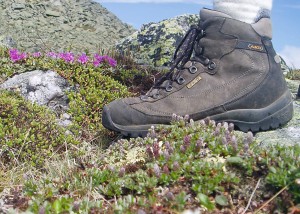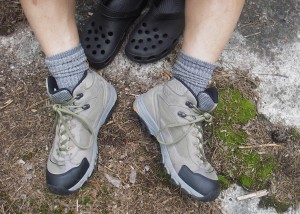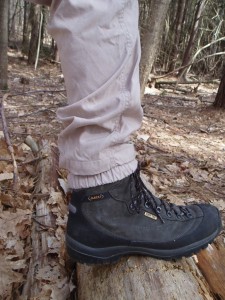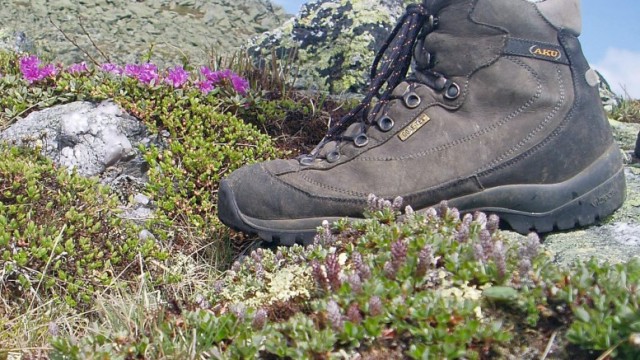
How To Pick Hiking Boots
If you aren’t wearing out the soles of at least one pair of hard-core outdoor boots a year, you are spending far too much time at work or in front of the TV and not enough time outdoors.
The most versatile footwear you can own is a comfortable pair of lightweight hiking boots. They’ll take you on a trail hike, over a mountain, or through the brush to a hidden stream, with a backpack or without, and even handle a city sidewalk, if that’s where you are forced to walk.
Unfortunately there’s no such thing as one perfect boot for all situations, but there are boots that will handle most situations. Your quest is for comfort and versatility. That way, you won’t have sore feet as an excuse.
Fit is the single most important criteria. Everyone’s feet are different, and every make and model of boot is slightly different. Buying boots via mail order or e-commerce is tricky. You might get lucky with fit, more likely you won’t. You’re better off at a good local sport shop with sales staff that knows what they are doing.
Before you head to the shop, consider how and where you will use your boots. Smooth trails dictate a whole different set of criteria than if you intend haul a 70-pound pack up and down mountains. Be realistic. You may dream of scaling Everest, but is that where you hike?
In the store, most hiking boots look alike. Height and padding are obvious, But much of what you see is cosmetic. For quality of the material and construction you have to read the literature and trust the manufacturer and retailer.
Here are some basic criteria:

Height: A boot that just covers the ankle gives plenty of support, even with a heavy pack. Higher boots do a better job of keeping out snow, mud and dirt, but low boots are lighter, easier to put on and take off.
Weight: Lighter is generally better. Extra support, cushioning and durability means extra weight. Get what you need, no more.
Flexibility/Support: A tradeoff. More flexibility means more comfort, less support. You can get a good idea of how comfortable a boot will be to walk in by simply taking it in both hands and bending the toe up toward the top of the boot. The more easily it flexes, the more natural the boot will feel. With a heavy pack, however, a more rigid sole adds support.
Stability: A good gauge of lateral stability is to grasp toe and heel and twist. The more resistance you feel, the more protection you have against twisting your ankle on uneven terrain. Also squeeze boot side to side just above the heel That’s the heel counter. More rigidity there helps to keep your foot stable.
Waterproofing: Waterproof hiking boots are not always necessary or desirable. If it’s cold and wet, waterproof/breathable is a good investment. But if you hike in the summer, waterproof boots are less breathable and, sometimes, less comfortable.
Price: A good pair of boots can last a long time and become like old friends. I’ve got a pair that are 15 years old and on their third set of soles. They may have to bury me in them. My advice is simple, if the fit is right and the other criteria match, don’t even think about price.
Good boots are like a magic carpet. They can take you almost anywhere you want to go, and keep you comfortable while you travel. Don’t scrimp on money or time when you go to buy them. You might be lucky and find a friend for life.

Step By Step: How to Pick Hiking Boots That Fit
Step 1: Before you try on boots, take a long walk. Feet swell and change shape with activity.
Step 2: Take your socks with you. With today’s socks, I find one pair of mid-weight socks do a better job than the old liner-sock/outer sock combination. NEVER wear cotton athletic socks inside hiking boots. Cotton absorbs water like a sponge and holds it. As the cotton becomes soaked, it compress and wrinkles, causing blisters and misery.
Step 3: If boots feel “right” when you put them on, they are very likely too small for you. Have your heel-to-toe length (one foot will almost always be longer than the other), width, and arch length (to the ball of your foot) measured on a Brannock device.
Step 4: Before you lace up, push your toes forward until they just touch the front of the boot. You should have about 1/2 inch of space behind your heel. If you have a high arch, you may want more space, flat feet can get away with a bit less. You need that space to keep from jamming your toes into the front of the boot while walking downhill.
Step 5: Tap your heel back into the heel cup. and lace the boot tight. The widest part of your foot should match the widest part of the boot. Pay particular attention to your baby toe. Unless you enjoy pain, find a pair with toe room.
Step 6: Walk up and down stairs or, better yet, on an inclined ramp. You want your heel held firmly. If your heel slips, you WILL get blisters. Heel fit problems are tough to correct, so if one boot doesn’t hold your heel firmly, try another model.
Step 7: Once you’ve gotten the right general fit, you can tweak it to perfection with different footbeds (thicker or thinner, firmer or more cushioned, if you have really tough feet you might want to consider custom orthotics) and different socks.
HAPPY FEET
One way to keep your feet happy while hiking is to carry spare socks and change them every few hours. Some people swear by foot powders, but dry, fresh wool hiking socks are even better.



Any advice for a good running shoe? Training for the Boston Marathon and about ready for new sneakers!
[…] Boots appropriate for snowshoeing (insulated is nice, heavy isn’t) […]